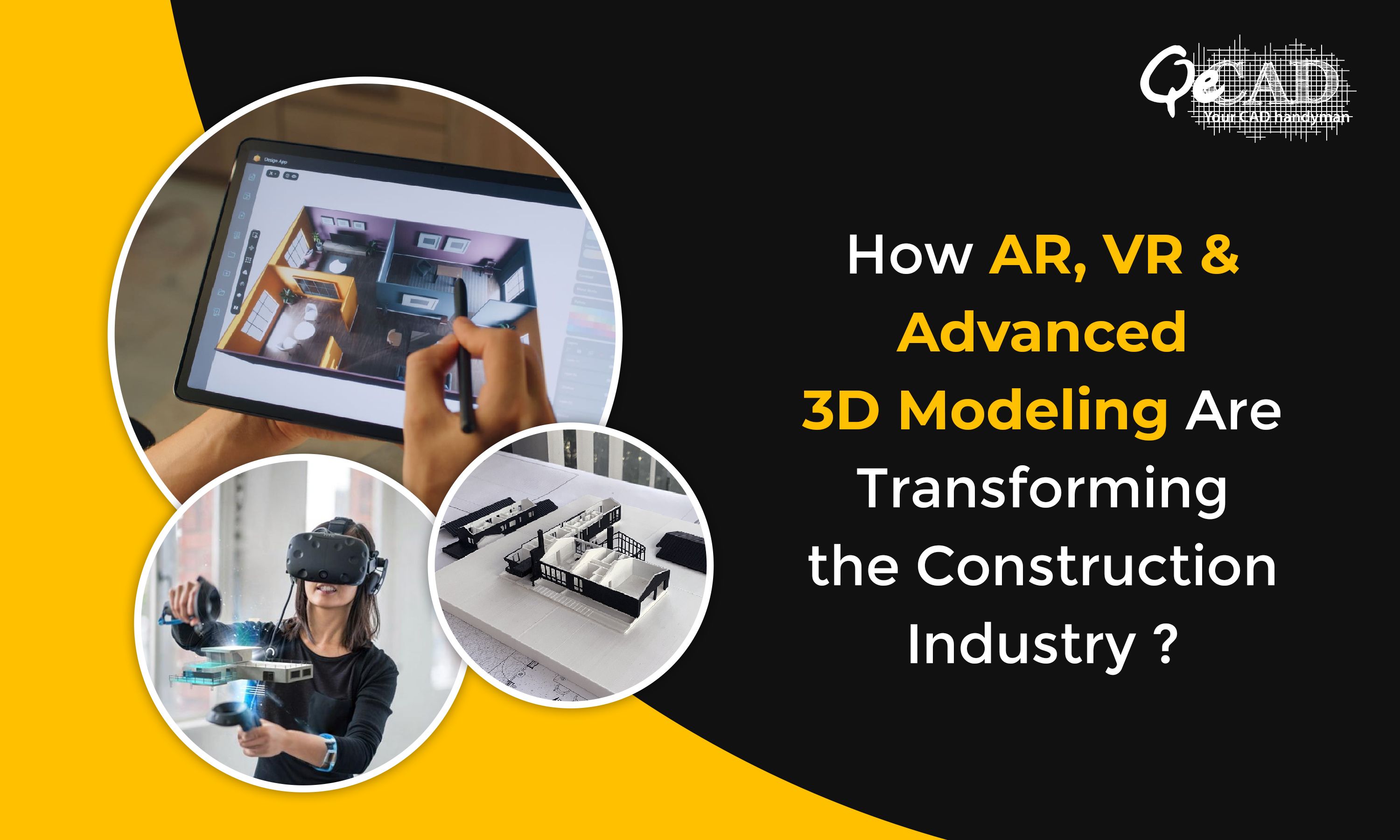
The construction industry is undergoing a digital revolution and at the heart of this transformation lies Augmented Reality (AR), Virtual Reality (VR) and advanced 3D modeling technologies. These innovations are reshaping traditional processes, enhancing collaboration and boosting precision and safety across every phase of a construction project.
In this blog, we’ll explore how AR, VR and 3D modeling are influencing the construction sector with real-world applications, key benefits and emerging trends.
1) Understanding the Technologies
Augmented Reality (AR)
AR overlays the digital information like plans, measurements and 3D elements on a real-world environment using the mobile devices, smart glasses or headsets. It allows the construction professionals to visualize how the elements fit into a physical space before they are built.
Virtual Reality (VR)
VR transports users into a completely immersive digital world. With VR headsets, architects, engineers and clients can “walk through” the digital models of a building long before a single brick is laid enabling the better design reviews and client approvals.
Advanced 3D Modeling
Advanced 3D modeling especially when combined with the BIM provides a rich, data-driven digital representation of a project. These models serves as the foundation for the AR/VR integrations enabling the precise planning, visualization and simulation.
2) Real-World Applications in Construction
➤ Design Visualization and Client Walkthroughs
Virtual walkthroughs built from the 3D models allows the stakeholders to explore the design interactively fostering the better understanding and quicker approvals.
➤ On-Site AR for Installation Guidance
Technicians and workers can use the AR-enabled devices to see pipe layouts, electrical conduits and HVAC systems superimposed on the actual job site reducing the risk of reworks.
➤ Safety Training and Risk Simulation
VR can simulate the hazardous construction scenarios in a controlled environment to train workers effectively leading to the fewer on-site accidents.
➤ Remote Collaboration
Teams across geographies can use VR to conduct design reviews, identify clashes and solve issues collaboratively without being on site.
➤ Clash Detection and Problem-Solving
Advanced 3D modeling helps to detect conflicts between the structural, MEP and architectural elements during the planning stage saving time and money in the later phases. Many firms now rely on the 3D BIM Modeling Services to deliver highly accurate and data-rich project models that enhances the coordination and execution.
3) Benefits That Drive Adoption
Enhanced Accuracy and Minimized Errors
Overlaying models on the real world ensures precise execution and early detection of the inconsistencies.
Faster Decision-Making
Clients and stakeholders can make the informed decisions faster by visually understanding the spatial arrangements and finishes.
Enhanced Collaboration
Real-time AR/VR sessions enables the AEC professionals to collaborate efficiently and resolve issues dynamically.
Cost and Time Savings
By catching the design issues early, reducing change orders and streamlining the workflows, these technologies directly contributes to the faster project completion and lower costs.
Boosted Marketing and Sales
Developers and real estate companies use VR to offer immersive previews to the potential buyers thereby improving the customer engagement and conversion rates.
4) Challenges to Consider
Despite the advantages, implementation of AR, VR and 3D modeling comes with the challenges:
- High initial investment in hardware and training
- Data compatibility and integration with the existing systems
- Learning curve for the traditional teams
That’s where BIM Outsourcing Services comes into play allowing the construction firms to access the skilled expertise and the latest technology without investing heavily in the in-house capabilities.
5) Future Outlook
The convergence of AR, VR and AI-powered 3D modeling is setting the stage for fully automated, digital construction workflows. As Digital Twins and Metaverse applications grows, the construction teams may soon simulate the entire life cycles of buildings right from the design to demolition in the virtual environments.
According to a MarketsandMarkets report, the AR & VR global market in the construction industry is expected to reach $3.4 billion by 2025, indicating the growing confidence and investment in these technologies.
Conclusion
The integration of AR, VR and advanced 3D modeling in construction is not only than just a trend—it is a game changing shift. These tools are not just improving the visualization; they are redefining how the buildings are designed, constructed as well as maintained.
The companies that adopt these technologies today position themselves as future-ready leaders delivering the projects with greater efficiency, accuracy and innovation.
Need help implementing AR/VR and 3D modeling in your next construction project?
Get in touch with QeCAD—your technology-driven partner for 3D visualization, BIM modeling and immersive walkthrough solutions.
